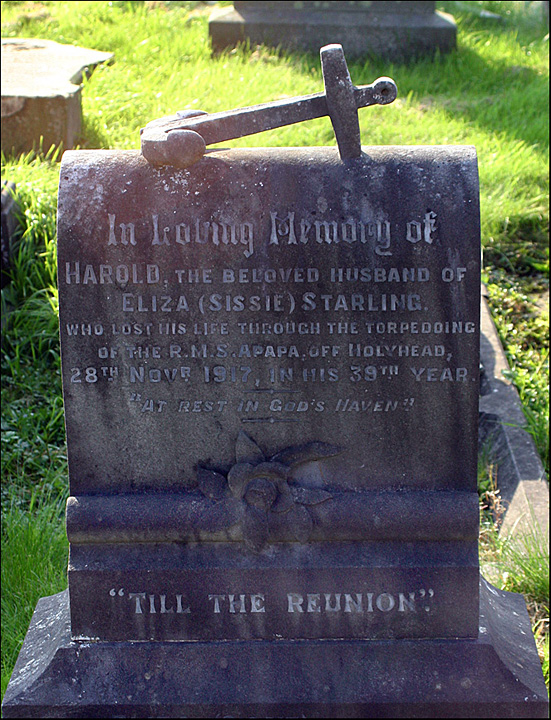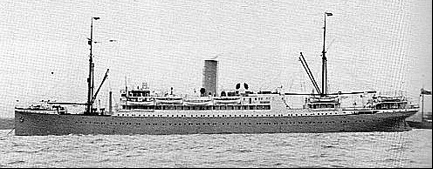|
Overleigh Gallery 14 |
A
Virtual
Stroll
Around
the
Walls
of
Chester Some Notable Memorials in the Overleigh Cemetery |
|

| This is the grave of 39 year old Harold Starling who was killed on the 28th November 1917 when his ship, S.S. Apapa, was torpedoed without warning and sunk by the German submarine U96 3 miles N by E from Lynas Point, near Amlwch, Anglesey. The SS Apapa was a twin-screw steel steamship and was built in 1914 by Harland & Wolff in Glasgow, as were also her quadruple expansion engines. Capable of fourteen knots, she was one of the largest ships in the Elder Dempster fleet and was commanded by Captain Toft. It was a clear moonlight night and she had just passed the Middle Mouse on her starboard bow when she suddenly shook from stem to stern. Many passengers were thrown from their bunks and it was obvious that she was sinking. At that time she was still on an even keel and the Captain ordered the engines to be stopped. Close examination showed that a torpedo had ripped a huge hole in the starboard side towards the stern of the ship, and Captain Toft then ordered that the boats should be lowered. As the lifeboats were being loaded, a man was seen disappearing down a companion-way. His mission was one from which he never returned. His name was Mr. Harragin, of the Gold Coast Customs, and he was coming home with his wife to spend a well-earned rest in England. She was lying in their cabin, ill with black-water fever and he tried to carry her on deck, but she declared herself too ill and too weak to be moved. And so he stayed with her- just two of the forty passengers who lost their lives. By this time many of the passengers were safely in the lifeboats and the ship had developed a list to starboard. Suddenly, there was a streak in the water and a second torpedo hit the ship, again on the starboard side but this time further forward. Some of the lifeboats were swamped and the ship lurched to starboard. As she did so, the stays supporting the funnel snapped and the funnel collapsed, falling onto a lifeboat that was loaded and was just about to be lowered into the water. It was this second torpedo that contributed to the large number of casualties. A few moments later the ship plunged stern first to the bottom of the sea. 63 survived but 77 died including poor Harold Starling, who lies today in Overleigh Cemetery.
"But the worst tragedy of the month was the sinking of the Elder Dempster liner, the Apapa (7,832 tons), at 4 a.m. on the 28th, both because no fewer than seventy-seven lives were lost, about equally divided between passengers and crew, and because most of these deaths were due to the callous and quite unnecessary firing of a second torpedo at the ship just at the moment when the boats had reached the water, and had not had time to pull away." "The Elder Dempster liner Apapa, Capt. Toft, one of the largest in the company's fleet at that time, was returning home from West Africa when she was torpedoed by a German submarine. The vessel had reached a position three miles N. by E. of Lynas Point, near Liverpool, when she was attacked at 4.10 a.m. on Wednesday, November 28th, 1917, when steaming at 13 knots. No sign of the submarine was visible to those on board. The torpedo exploded on the starboard side nearly amidships, extinguishing the electric light and making the work of mustering the passengers much more difficult, but fortunately the sea was calm, with brilliant moonlight. Capt. Toft managed to launch a number of boats without mishap, but ten minutes after the first attack a second torpedo struck one of the boats containing from 20 to 30 people and killed or drowned the majority. There were 249 persons on board the Apapa, of whom 129 were passengers, and 40 passengers and 37 crew were lost. Capt. Toft went down with the ship, but came to the surface and was rescued." Much of the information here was condensed from this excellent thread of the Great War Forum. |
Grosvenor Bridge & Overleigh Cemetery | Cemetery Gallery Introduction | Overleigh Gallery 16 | The Overleigh Cemetery Database Online
Top
of
Page
|
Site
Index
|
Site
Front
Door
|
Chester
Stroll
Introduction | Write to us | Next Page
